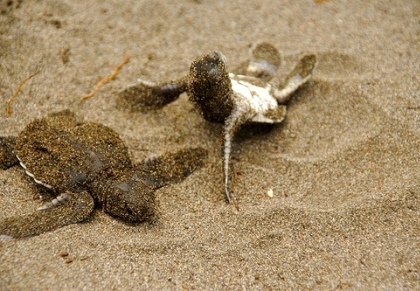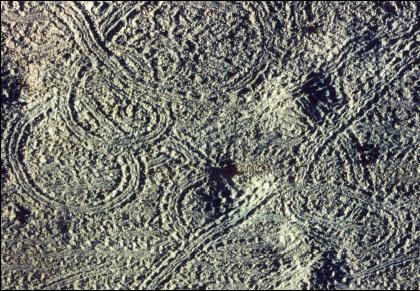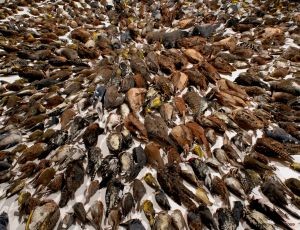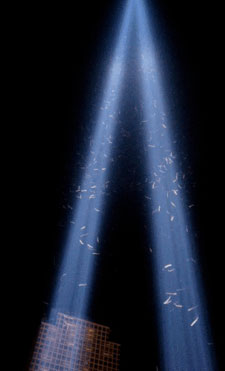Once the lonely crusade of astronomers, the dark-sky movement is finding increasingly vocal support in the lighting community; and is gaining regulatory traction with the sustainability and conservation movements.
Plants and animals, including humans, are attuned to the 24-hour seasonal cycle of light and dark that has ruled the planet for millions of years. Mating behaviors, the timing of migration, sleep, and predation are all determined by the length of nighttime darkness. Introducing electric light into the landscape and into the atmosphere, in the form of skyglow, can disrupt these cycles and patterns. Unlike the developer's bulldozer, light pollution destroys natural habitats insidiously.
For instance, firefly populations worldwide are believed to be in decline, in part due to light pollution. Each species of firefly uses a fairly distinctive flash pattern to attract a suitable mate, and research is ongoing to see whether outdoor lighting can cause failure to mate. Preliminary results from the Firefly Watch citizen-science project coordinated by the Museum of Science, Boston, has determined that at least some species are found in higher populations away from streetlights. Another small study of one species shows that females located in areas closer to streetlights attracted fewer courting males.
James Miles, a design engineer with Kingfisher Lighting, wrote that lighting's effects on insect populations has far-reaching ramifications. "Two-thirds of the animal protein consumed on our planet comes from insects. They lie at the bottom of the global predator-prey food pyramid." He cites the example of the burrowing mayfly, which in its adult stage leaves the water and flies in search of a mate. This mayfly has just a few hours, perhaps a few days, to reproduce. Electric lights draw the mayflies irresistibly, "vacuuming" the insects out of the surrounding habitat for perhaps hundreds of meters. "Their swarming to lamps on bridges or by riversides gives them the nickname the 'summer snow,' as the ground near lights becomes centimeters thick with their bodies," Miles wrote. This represents an enormous loss for the species and its aquatic predators.
Lighting that interferes with the circadian rhythms of certain songbirds can cause males to sing earlier in the morning, which seems to attract females. Is this early-bird male indeed the most robust male available, or is it a sleep-deprived male who luckily roosted near a streetlight?
Among larger species, light pollution may disrupt an animal's movements and corridor use. Owls, bats, raccoons, and coyotes can lose the advantage of specialized night vision which enables them to hunt without being seen. Even so, light generally favors predators, as the nocturnal animals that are their prey lose the cover of darkness to hide. Rodents and amphibians, which are both predator and prey, seem to prosper.
The rising tide of energy-efficient LED streetlighting could prove a doubled-edged sword in terms of light pollution impacts on wildlife. LED technology lends itself to control in terms of both beampattern and dimming/switching; therefore careful deployment of LED lighting using higher levels of control could abate some of the problems caused by light pollution. However, the replacement of HPS street- and area lighting with LED could introduce a major change in the color of urban skyglow. The higher blue content in LED lighting is more subject to scattering in the atmosphere, especially by cloud cover, thus increasing skyglow. In addition, the blue spectra have a greater impact on melatonin production and could further disrupt sleep patterns in diurnal animals, including humans.
James Karl Fischer, president of the not-for-profit Zoological Lighting Institute and principal of Zoological Lighting Services , is concerned: "Efficiency is great for saving money, but it must be combined with light output. Overall, outdoor light levels keep going up and up and up, and more efficient sources contribute to that. It's not as if energy consumption is being cut. It's as high as it's ever been."


Codes and legislation; the poster child for light pollution
In increasing numbers, communities are adopting light pollution and trespass ordinances, many based on the Model Lighting Ordinance (MLO) developed by the International Dark-Sky Association in cooperation with the Illuminating Engineering Society. In addition, broad animal conservation laws could theoretically be construed and enforced to curtail lighting where protected species or habitats are concerned. Third, ordinances have been developed, addressing lighting specifically, to protect individual species or habitats.
The poster child for light pollution and wildlife conservation has to be the baby sea turtle. Stretches of Florida's highly developed coast are nesting grounds for rare loggerhead, leatherback and green turtles. Bright lights nearby discourage females from coming ashore to nest. But more important, hatchlings can become disoriented by manmade lighting and fail to find their way quickly to the relative safety of the open sea.
Over millions of years, the newly hatched sea turtles developed instincts to frenetically crawl toward the lightest horizon, because the ocean breakers would reflect starlight. In the past 100 years, the lighting situation has changed dramatically. Instead of heading directly into the sea, hatchlings go toward the brighter light. Those that wander in circels on the sand have a much higher risk of dying of dehydration,?exhaustion or predation.
Along the Florida coastline a patchwork of "turtle lighting" ordinances require careful positioning and aiming of full-cutoff light fixtures; low-pressure sodium lighting or yellow "bug" lights and window treatments to shield indoor lighting.
Karen Shudes, sea turtle lighting specialist at the Sea Turtle Conservancy, has been retrofitting lighting at targeted properties where Florida State surveyors have reported dead hatchlings. Where she has retrofitted lights with red or amber LED lighting – which emit wavelengths that are least disturbing to nesting females and hatchlings – Shudes has observed a 100% decrease in hatchling-disorientation reports.
Bats are another obvious, but nuanced case. Contrary to popular myth, bats are not blind: most carnivorous bats have enhanced night vision, which plays an important role in avoiding predators, such as owls or cats, during foraging. For some species, local streetlights provide a smorgasbord of insect prey nightly. But several species of bats do not forage at streetlights and are rarely seen in illuminated areas. It could be to evade predators, but it is possible that bats have poor vision at higher light levels. Some bats will travel out of their way to avoid lighted areas, or even be barred from reaching a desired hunting ground by a row of continuous streetlighting. Others delay their nightly emergence in the presence of ambient electric lighting, which shortens feeding time.
Globally, bats are represented by 1100 species, many of which are threatened. Numbers are declining rapidly in the US, which could lead to higher populations of nighttime insects, including mosquitoes and insects that attack farm and garden crops. In the UK all 17 species of bats are protected: "This makes it illegal deliberately or recklessly to kill, injure, capture or disturb bats, obstruct access to bat roosts or damage or destroy bat roosts. Lighting in the vicinity of a bat roost that causes disturbance could constitute an offence, unless the local Statutory Nature Conservation Organisation has been consulted and allowed time to provide advice," according to Miles.
The International Green Construction Code (IGCC) includes light pollution and trespass control provisions as an elective code requirement, providing a valuable framework for those communities wishing to curtail light pollution. Where it is adopted, ASHRAE Standard 189.1 for high-performance, green building makes reduction of light pollution mandatory. It limits illumination of parking lots or hardscape areas and uses the luminaire BUG ratings (backlight-uplight-glare) and lighting zones (which reflect the base light levels and obtrusive light measures desired by a community) developed for the MLO.


Birds and voluntary light pollution codes
I was surprised to find out that many diurnal birds migrate at night in order to avoid predation and use the daylight hours for foraging. These species, largely songbirds, use celestial cues for navigation, so skyglow can cause disorientation. In addition, dazzling city lights can confuse migrating birds and lure them into urban areas. Birds attracted by light may collide with buildings or circle light sources endlessly until they are exhausted.
The Lights Out program, fostered by the National Audubon Society and its chapters, is now underway in 21 North American cities (Toronto, New York, Chicago, Detroit, Boston, Baltimore, Minneapolis, Houston, San Francisco, Indianapolis, etc). This voluntary program enlists building owners to turn unnecessary lights off during migration seasons. In Chicago alone, where the first Lights Out program originated, researchers estimate that the initiative saves the lives of more than 10,000 migratory land birds each year. Audubon and the Chicago Audubon Society join forces with the City of Chicago, the Building Owners and Managers Association of Chicago, and the Field Museum in this community effort.
Light Out focuses on tall buildings and rooftop architectural lighting. Buildings can also extinguish interior lighting on upper floors, move maintenance and cleaning activities to daytime hours, turn off sign uplighting and ensure that outdoor lights are properly shielded.
Bird safety has made its way into another voluntary program, the USGBC's LEED green building program, though it primarily focuses on bird collisions due to reflections in windows. However, to take advantage of Pilot Credit 55: Bird Collision Deterrence architects must develop a lighting design strategy to effectively eliminate or reduce light trespass from exterior fixtures and from inside the building. A post-construction monitoring plan is required to monitor bird collisions and to implement remediation. Indeed, LEED credits for light pollution reduction, which use the same rubrics as the MLO, mention wildlife as well.
Golsana Heshmati, a lighting designer with Auerbach Glasow French, Architectural Lighting Design and Consulting, is also working with the Zoological Lighting Institute to advocate for wildlife conservation. "Architects talk a lot about glass, but not the bird collision issue. They are not taking these effects into consideration," she said. Heshmati laments that most architects are generally not concerned with light pollution unless ordinances are in effect, but the LEED point specifically focusing on bird safety is helping raise awareness. "Bird safety in the definition of green building is really going to change how they view both interior and exterior lighting and controls."
In 2011, 10,000 birds were reported to be "trapped" in the powerful beams of the Tribute in Light 9/11 memorial in New York City. Working with the Audubon Society, the Municipal Arts Society, which organizes the annual tribute, switched off the lights several times, allowing the birds to clear the area. However, even those birds that were not injured and continued on their migration expended valuable energy during the time (or times) they were unable to navigate out of the beams.
The 2012 public art piece Open Air, in which searchlights lit up the sky over Philadelphia, raised protests from dark-sky advocates. "About a third of all vertebrates and two-thirds of invertebrates are nocturnal. For many of these animals, the introduction of artificial light probably represents the most drastic change human beings have made to their environment," wrote Christopher Kyba, a light pollution researcher at the Freie Universit?t Berlin. "Near cities, cloudy skies are now hundreds, or even thousands of times brighter than they were 200 years ago. We are only beginning to learn what a drastic effect this has had on nocturnal ecology."





